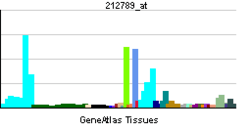NCAPD3
Condensin-2 complex subunit D3 (CAP-D3) also known as non-SMC condensin II complex subunit D3 (NCAPD3) is a protein that in humans is encoded by the NCAPD3 gene.[1][2][3][4] CAP-D3 is a subunit of condensin II, a large protein complex involved in chromosome condensation.
References
- ↑ Nomura N, Nagase T, Miyajima N, Sazuka T, Tanaka A, Sato S, Seki N, Kawarabayasi Y, Ishikawa K, Tabata S (December 1995). "Prediction of the coding sequences of unidentified human genes. II. The coding sequences of 40 new genes (KIAA0041-KIAA0080) deduced by analysis of cDNA clones from human cell line KG-1". DNA Research 1 (5): 223–229. doi:10.1093/dnares/1.5.223. PMID 7584044.
- ↑ Andersson B, Wentland MA, Ricafrente JY, Liu W, Gibbs RA (June 1996). "A "double adaptor" method for improved shotgun library construction". Analytical Biochemistry 236 (1): 107–113. doi:10.1006/abio.1996.0138. PMID 8619474.
- ↑ Ono T, Losada A, Hirano M, Myers MP, Neuwald AF, Hirano T (October 2003). "Differential contributions of condensin I and condensin II to mitotic chromosome architecture in vertebrate cells". Cell 115 (1): 109–121. doi:10.1016/S0092-8674(03)00724-4. PMID 14532007.
- ↑ "NCAPD3 non-SMC condensin II complex, subunit D3". National Center for Biotechnology Information. Retrieved June 10, 2012.
Further reading
- Yu W, Andersson B, Worley KC et al. (1997). "Large-scale concatenation cDNA sequencing.". Genome Res. 7 (4): 353–8. doi:10.1101/gr.7.4.353. PMC 139146. PMID 9110174.
- Strausberg RL, Feingold EA, Grouse LH et al. (2003). "Generation and initial analysis of more than 15,000 full-length human and mouse cDNA sequences.". Proc. Natl. Acad. Sci. U.S.A. 99 (26): 16899–903. doi:10.1073/pnas.242603899. PMC 139241. PMID 12477932.
- Ota T, Suzuki Y, Nishikawa T et al. (2004). "Complete sequencing and characterization of 21,243 full-length human cDNAs.". Nat. Genet. 36 (1): 40–5. doi:10.1038/ng1285. PMID 14702039.
- Beausoleil SA, Jedrychowski M, Schwartz D et al. (2004). "Large-scale characterization of HeLa cell nuclear phosphoproteins.". Proc. Natl. Acad. Sci. U.S.A. 101 (33): 12130–5. doi:10.1073/pnas.0404720101. PMC 514446. PMID 15302935.
- Gerhard DS, Wagner L, Feingold EA et al. (2004). "The status, quality, and expansion of the NIH full-length cDNA project: the Mammalian Gene Collection (MGC).". Genome Res. 14 (10B): 2121–7. doi:10.1101/gr.2596504. PMC 528928. PMID 15489334.
- Andersen JS, Lam YW, Leung AK et al. (2005). "Nucleolar proteome dynamics.". Nature 433 (7021): 77–83. doi:10.1038/nature03207. PMID 15635413.
- Nousiainen M, Silljé HH, Sauer G et al. (2006). "Phosphoproteome analysis of the human mitotic spindle.". Proc. Natl. Acad. Sci. U.S.A. 103 (14): 5391–6. doi:10.1073/pnas.0507066103. PMC 1459365. PMID 16565220.
|
|---|
| Envelope (membrane)/
nuclear lamina | |
|---|
| | Nucleolus | |
|---|
| | Other | |
|---|
| see also nucleus diseases
Index of cells |
|---|
| | Description |
- Structure
- Organelles
- peroxisome
- cytoskeleton
- centrosome
- epithelia
- cilia
- mitochondria
- Membranes
- Membrane transport
- ion channels
- vesicular transport
- solute carrier
- ABC transporters
- ATPase
- oxidoreduction-driven
|
|---|
| | Disease |
- Structural
- peroxisome
- cytoskeleton
- cilia
- mitochondria
- nucleus
- scleroprotein
- Membrane
- channelopathy
- solute carrier
- ATPase
- ABC transporters
- other
- extracellular ligands
- cell surface receptors
- intracellular signalling
- Vesicular transport
- Pore-forming toxins
|
|---|
|
|
